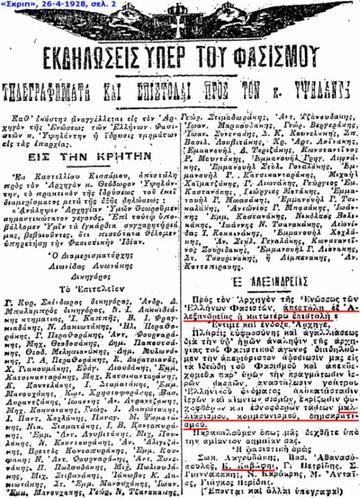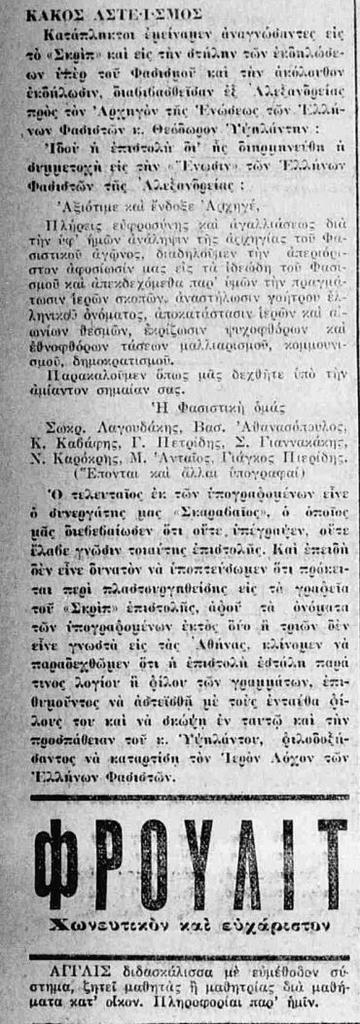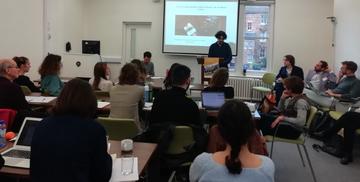C.P. Cavafy and the Golden Dawn: An Archival Affair
At the Oxford conference “Modern Greek Studies in the 21st Century: Perspectives and Practices in Cultural Analysis,” my talk revolved around C.P. Cavafy’s mobilisation by the Greek neo-nazi party Golden Dawn (GD). GD’s use of Cavafy was discussed lately in the public sphere following a speech given by the GD leader Nikos Michaloliakos at Alimos, in which he recited a poem by Cavafy by heart. Yet this evocation of Cavafy by GD was neither an isolated instance, nor something that should come as a surprise, since Cavafy as well as other Greek national poets figure quite often in GD’s publications.
My research centres on practices of cultural appropriation by far-right parties and formations in Greece, with a focus on GD. Under which conditions does GD manage to integrate cultural personas and objects in its narrative, what enables it to do so, and what does are the implications of this practice? Can a cultural object mobilised for political purposes speak back, and what does that entail for the object’s political force? In what follows I briefly present some of the points I made at the conference and expand on some of them to show how they relate to my bigger project on GD’s mobilisation of Cavafy.
In my presentation I focused on the way Cavafy’s “archive” is presented, analysed, and cited by GD, by zooming in on a publication celebrating 150 years since Cavafy’s birth. Although no author is mentioned, it is most likely written by Michaloliakos himself, as he is the one who cites Cavafy the most in GD. The article is accompanied by a short and conventional biographical note of Cavafy, largely plagiarised - almost copy-pasted - from another text that has been slightly edited. The original piece, which GD plagiarised, is written by Manuel Savidis, and can be found both on the website of Ikaros Publications under Cavafy’s entry in the author’s section, as well as on the old website of the Cavafy Archive. In Michaloliakos’ use of this bio it is still possible to identify his personal touch through his edits. Posted as it is on a far-right website, the bio seems to be celebrating Cavafy’s national-socialist beliefs and proceeds by seemingly condemning Cavafy’s sexual identity, which it considers incompatible with GD’s norms. It thus allows a far-right point of view to emerge from the plagiarised text. Both the ‘nationalist’ as well as the ‘homosexual’ Cavafy are undoubtedly Michaloliakos’ additions; Savidis neither explicitly mentions Cavafy as a nationalist, nor does he present him as homosexual per se.
Michaloliakos’ publication includes a widely-debated “Letter of Declaration of Support to Fascism” (Letter), which comes to function here as further proof of Cavafy’s hellenocentrism and national socialism. Needless to say, the Letter became an object of contestation between the far-right and those seeking to protect Cavafy from such a far-right appropriation. What concerned both sides was the issue of whether the Letter could be attributed to Cavafy.

[The Letter’s image as found on GD’s old website, in the new post on the new malfunctioning website it cannot be found anymore.]
The historian Sarantos Kargakos was researching the 1928 Korinthos earthquake when he discovered the Letter, signed among others by Cavafy. That Letter was a rather unfunny farce, published on 26 April 1928 in the Alexandrian newspaper SKRIP. Kargakos, however, took it for a real one and published a book, called C.P. Cavafy, The Modern Egyptian Sphinx (2009), where he examined Cavafy’s supposed flirting with fascism. The book received practically zero attention by academics. Rather than challenging Kargakos’ argument itself, scholars challenged the Letter’s discovery and substantiality, and dismissed it using fact-checking. Nevertheless, the Letter fared better outside scholarly circles and was soon re-posted on nationalistic blogs, eventually finding its way to GD’s website where it still remains, presenting Cavafy as a national socialist. The best-known reaction to such uses of this Letter, still available online, came from Nikos Sarantakos, a Greek blogger who writes on issues of translation, literature, and linguistics. Sarantakos responded to the Letter in two articles, one in 2010 and one in 2012. He only had to search in the online library of the Greek Parliament to find a declaration in the Tuesday version of Ταχυδρόμος (Postman) on 1 May 1928, where some of the individuals that purportedly co-signed the Letter stated their dissatisfaction with the distasteful farce. Sarantakos also attached a .jpg file from the online database for all the readers to see. Both Kargakos and his fact-checkers, that is, those who criticised his discovery in discussions that took place in online blogs, focused on the Letter from the newspaper SKRIP in order to discuss whether or not Cavafy was a national-socialist. Instead of settling the matter by looking at Cavafy’s poetic corpus, the focus was on whether the Letter was real, and whether it was rebuked afterwards by the outraged Alexandrians who had been presented as the signers of the fascist declaration. The arguments countering Kargakos’ position revolved around the fact that the Letter was a farce, that Cavafy would have never signed something like that, or that a scholar dealing with Cavafy should never fall for such a farce. A question that arises here is this: in what sense can an exposed archive be considered real, true, present, reliable?

[The image of the Declaration in the Tuesday version of Ταχυδρόμος (Postman), 1.5.1928. It is as found on Sarantakos’ website (2012).]
On GD’s official website, authors occasionally offer expositions of what they label as a ‘misreading’ of the poet by others, claiming expertise on Cavafy and knowledge of the ‘true’ Cavafy, and thereby performing as ‘national philologists’. Instead of fact-checking the ‘far right Cavafy’ in order to discredit the uses of his work in this context – which would be an easy task – my research revolves around the strategies employed in this appropriation of Cavafy and their implications. I do not aspire to discern what or upon what GD thinks, but how, and the implications of this process; in other words, I am concerned with the analytic and expository actions involved in the appropriation of Cavafy’s works by GD members. The analysis of these acts of appropriation foregrounds the relation of GD’s practices to the institution of literature, and by extension, in this specific instance, national culture.
I consider what GD does with Cavafy on its website to be a multifaceted exposition. GD does not simply transcribe the Letter; they present us with a .jpg photo of it as proof of its undeniable truth. This exposition thus happens through an exhibition of sorts that involves two subjects; apart from Cavafy co-signing the Letter, there is also the exhibitor. Two exposures take place here: Cavafy’s supposed relation to national-socialism/fascism, and the author’s (i.e. Michaloliakos’) ability to perform as a philologist - to produce, in other words, a specific ‘Cavafy’. As an object, this specific ‘Cavafy’ seems to have a peculiar position: his silence and the background against which it is exhibited are troubling.
One could very well consider xrisiavgi.com (GD’s official website) a museum of sorts, albeit one that is not particularly open to radical approaches towards its exhibits. In museums, the objects in the expositions do not talk (or make sounds in general, unless one is in a multi-sensory installation), but may talk back to our attempts to scrutinise them. Yet, in this specific instance of archival exposition, Cavafy, who supposedly talked in the past through this declamatory Letter, is now silent. Although silence could still be a modality of speaking, in this instance, the supposed ‘archive,’ the Letter, speaks instead of Cavafy, and what is more, it legitimises a specific archival approach towards his work. Here, Michaloliakos’ ‘respectful’ treatment of a piece of archive, the Letter, essentially amounts to a disrespectful approach to a cultural object, that being none other than the subject ‘Cavafy.’ What we witness is the denial of Cavafy’s capacity, as a cultural object, to check the thrust of an interpretation, as this capacity is transferred to the Letter itself, an archival piece. The Letter’s exposition essentially serves to counter any possible attempt to refute Cavafy’s national-socialism by appealing to his poetic corpus or/and biography. Should such an attempt be made, the Letter will stubbornly keep returning as proof of Cavafy’s national-socialism. The Letter’s authority results from the purported credibility that its archival nature grants it. In the end, the Letter renders any potential attempt at interpreting Cavafy’ s work or life narrative irrelevant. Michaloliakos essentially issues two injunctions through his gesture of showing, through this exposition. “Look!” and “Thats how it is!”
Further unpacking the idea of GD’s website as a museum, I consider this archival manifestation by GD as a metaphor where the subject that exhibits acts as a national curator. He (with an emphasis on the gender) hangs objects with a supposedly non-debatable truth-status, such as the Letter, on the wall (here an internet website), thereby claiming epistemic authority and situating the poet, Cavafy, within his far-right ranks: a Cavafy that is thereby rendered mute as a cultural object, unable to speak back.
The notion that “the object speaks back,” proposed by Mieke Bal as a key component of her approach to cultural analysis, differs from the common statement that some objects are supposed to talk by themselves, exhibited as ‘masterpieces,’ or that objects actually talk by themselves and not in a dialectical manner. The epistemology behind such approaches eventually renders objects mute. As I argued, silence does not necessarily entail muteness. Muteness is actually an effacement, since to mute an object is not only about taking away its ability to speak; rather it is to separate the poetic from the political, to deprive the object of its potentiality to resist, and thus of its ability to occupy a political space, which is also a space of potential resistance to appropriation. My argument here is not exactly to say that the object should have the last word against any analysis aimed towards it; as I stated earlier, GD’s interpretations are based on supposed proof, and indeed they seem to have the last word no matter what. I use the word ‘proof,’ since what is presented is an affectively charged material object carrying connotations of archive, truthfulness, and authenticity. Therefore, in GD’s worldview, objects don’t talk back, they prove, they dictate.
What sort of objects are these, objects whose readings have already been produced, but are now muted? The exhibited object, the Letter, might have in reality been a farce, but the connoted object, Cavafy’s hellenocentrism, was very real: that is, it had already been produced by a certain strand of Cavafian criticism. Of course, GD hasn’t produced any monographs on Cavafy, nor does it seem interested in doing so. Michaloliakos uses and inserts - via his quasi-philological performance - peculiar versions of cultural objects into GD’s literary canon.
Therefore, to say that GD appropriates Cavafy is not enough to describe the mechanisms in place. You appropriate something that you do not already own and assume that it belongs to someone else or is in public domain. Apparently, GD, considering itself an ambassador of Greece and Nationalism, believes it already owns “Cavafy,” since according to Michaloliakos, “Hellas doesn’t give away a Greek to the sickly anti-hellenic status quo.” You cannot give away something you don’t possess; the product ‘Cavafy’ belongs to nationalism, no matter who the Arkhōn of the archive might be. Questions of ownership, implied in the notion of appropriation, are raised here. Where or to whom do poets belong, or who owns poets? So far I have argued that for GD, ownership precedes interpretation. GD’s take on the matter follows this principle and allows us to consider ownership as a privilege of the meaning-maker, who engages in acts that renew one’s ownership. Cavafy’s archive belongs to the one that makes sense of it. Interpretation follows and renews ownership. Yet GD’s interpretations and analyses, at least in Cavafy’s case, do not surprise any potential reader and consist mostly of plagiarism, so one could wonder if GD’s take on Cavafy actually belongs to GD itself. It is for this reason that I opt to use the term cultural mobilisation rather than cultural appropriation. Appropriation points towards ownership and, as seen in GD’s case, what is mobilised in a way already belongs to the mobiliser, thus making it more accurate to talk of mobilising rather than appropriating cultural objects.
Acts involve actors, but Michaloliakos is more than an actor since he is in a position of authority, able to claim a certain externality from, and thus invulnerability to, criticism. We could thus consider Michaloliakos in this epistemological theatre as a prompter rather than an actor. This position needs to maintain a slight connection with ‘reality’ through the archive’s materiality, which is impossible to ignore, as well as paths already opened by practitioners of the discipline of philology, whose publications could be seen as the books such a prompter reads from.
Yiorgos-Evgenios Douliakas was born in Katerini and studied Greek Philology in the University of Ioannina. He went to Prague twice as part of Erasmus+ program, once for studies and after that as an intern in Charles University. He holds an MA in Cultural Analysis from Leiden University. His thesis was an examination of the Greek far-right’s use of cultural figures, focusing on Golden Dawn’s mobilisation of C.P. Cavafy. Right now, he is preparing a PhD project, revolving around the Trial of Golden Dawn.

Yiorgos Evgenios Douliakas (Leiden University) C.P. Cavafy and the Golden Dawn: An Archival Affair


